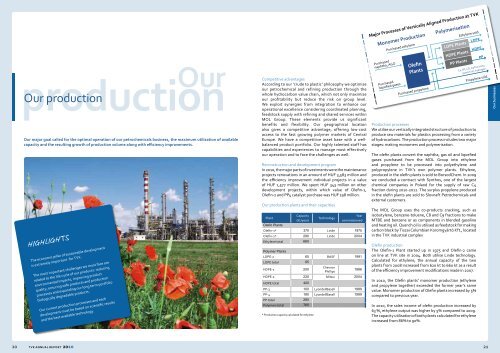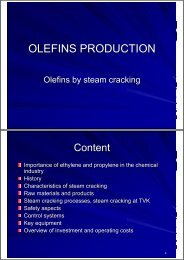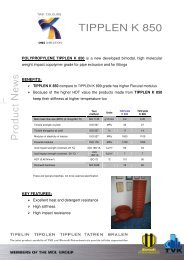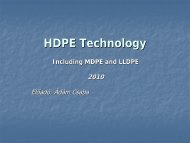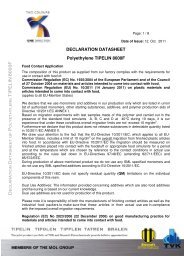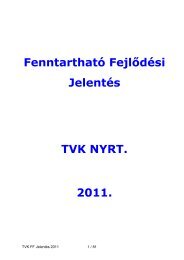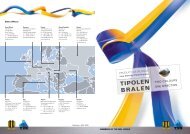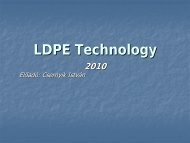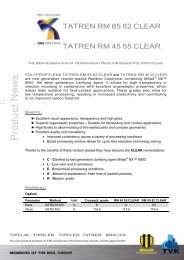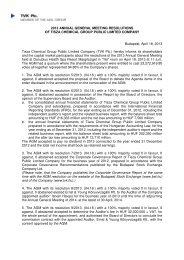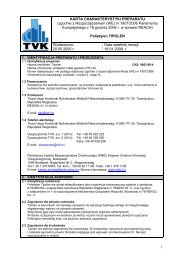TVK Annual Report 2010 (pdf, 2.5 MB)
TVK Annual Report 2010 (pdf, 2.5 MB)
TVK Annual Report 2010 (pdf, 2.5 MB)
Create successful ePaper yourself
Turn your PDF publications into a flip-book with our unique Google optimized e-Paper software.
Our<br />
Our production<br />
Our major goal called for the optimal operation of our petrochemicals business, the maximum utilization of available<br />
capacity and the resulting growth of production volume along with efficiency improvements.<br />
Highlights<br />
The economic pillar of sustainable development<br />
is extremely important for <strong>TVK</strong>.<br />
The most important challenges we must face are<br />
related to the life cycle of our products: reducing<br />
environmental impacts, improving product<br />
quality, ensuring safe products and production<br />
processes and expanding our long term portfolio<br />
biologically degradable products.<br />
Our current production processes and each<br />
development must be based on scientific results<br />
and the best available technology.<br />
Competitive advantages<br />
According to our ‘crude to plastic’ philosophy we optimize<br />
our petrochemical and refining production through the<br />
whole hydrocarbon value chain, which not only maximize<br />
our profitability but reduce the risk on group level.<br />
We exploit synergies from integration to enhance our<br />
operational excellence considering coordinated planning,<br />
feedstock supply with refining and shared services within<br />
MOL Group. These elements provide us significant<br />
benefits and flexibility. Our geographical location<br />
also gives a competitive advantage, offering low-cost<br />
access to the fast growing polymer markets of Central<br />
Europe. We have a competitive asset base with a wellbalanced<br />
product portfolio. Our highly talented staff has<br />
capabilities and experiences to manage most effectively<br />
our operation and to face the challenges as well.<br />
Reconstruction and development program<br />
In <strong>2010</strong>, the major parts of investments were the maintenance<br />
projects renovations in an amount of HUF 3,583 million and<br />
the efficiency improvement individual projects in a value<br />
of HUF 1,577 million. We spent HUF 343 million on other<br />
development projects, within which value of Olefin-1,<br />
Olefin-2 and PP4 catalyst purchase was HUF 198 million.<br />
Our production plants and their capacities<br />
Plant<br />
Capacity<br />
(kt/year)<br />
Technology<br />
Year<br />
commissioned<br />
Olefin Plants<br />
Olefin-1* 370 Linde 1975<br />
Olefin-2* 290 Linde 2004<br />
Ethylene total 660<br />
Polymer Plants<br />
LDPE-2 65 BASF 1991<br />
LDPE total 65<br />
HDPE-1 200<br />
Chevron<br />
Phillips<br />
1986<br />
HDPE-2 220 Mitsui 2004<br />
HDPE total 420<br />
PP-3 100 LyondellBasell 1989<br />
PP-4 180 LyondellBasell 1999<br />
PP total 280<br />
Polymers total 765<br />
* Production capacity calculated for ethylene<br />
Major Processes of Vertically Aligned Production at <strong>TVK</strong><br />
Monomer Production Polymerisation<br />
Purchased<br />
naphtha, AGO<br />
LDPE<br />
Production processes<br />
We utilise our vertically integrated structure of production to<br />
produce raw materials for plastics processing from a variety<br />
of hydrocarbons. The production process includes two major<br />
stages: making monomers and polymerisation.<br />
The olefin plants convert the naphtha, gas oil and liquefied<br />
gases purchased from the MOL Group into ethylene<br />
and propylene to be processed into polyethylene and<br />
polypropylene in <strong>TVK</strong>’s own polymer plants. Ethylene,<br />
produced in the olefin plants is sold to BorsodChem. In 2009<br />
we concluded a contract with Synthos, one of the largest<br />
chemical companies in Poland for the supply of raw C4<br />
fraction during <strong>2010</strong>-2012. The surplus propylene produced<br />
in the olefin plants are sold to Slovnaft Petrochemicals and<br />
external customers.<br />
The MOL Group uses the co-products cracking, such as<br />
isobutylene, benzene-toluene, C8 and C9 fractions to make<br />
MTBE and benzene or as components in blended gasoline<br />
and heating oil. Quench oil is utilised as feedstock for making<br />
carbon black by Tiszai Columbian Koromgyártó Kft., located<br />
in the <strong>TVK</strong> industrial complex<br />
Olefin production<br />
The Olefin-1 Plant started up in 1975 and Olefin-2 came<br />
on line at <strong>TVK</strong> site in 2004. Both utilise Linde technology.<br />
Calculated for ethylene, the annual capacity of the two<br />
plants from 2008 increased from 620 kt to 660 kt as a result<br />
of the efficiency improvement modifications made in 2007.<br />
In <strong>2010</strong>, the Olefin plants’ monomer production (ethylene<br />
and propylene together) exceeded the former year’s same<br />
value. Monomer production of Olefin plants increased by 5%<br />
compared to previous year.<br />
In <strong>2010</strong>, the sales income of olefin production increased by<br />
63 %, ethylene output was higher by 5% compared to 2009.<br />
The capacity utilisation of both plants calculated for ethylene<br />
increased from 86% to 90%.<br />
HDPE<br />
Purchased ethylene Ethylene sold<br />
Purchased<br />
liquefied gases<br />
Purchased propylene<br />
LDPE Plants<br />
HDPE Plants<br />
Olefin<br />
Plants PP Plants<br />
PP<br />
C4, BT, C8, C9 fractions,<br />
quench oil, hydrogen<br />
Propylene sold<br />
Our businesses<br />
20 <strong>TVK</strong> <strong>Annual</strong> <strong>Report</strong> <strong>2010</strong><br />
21


